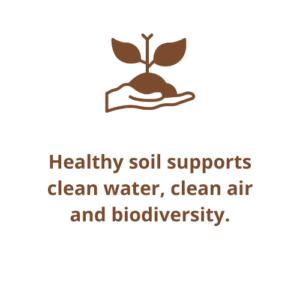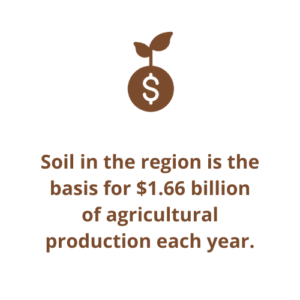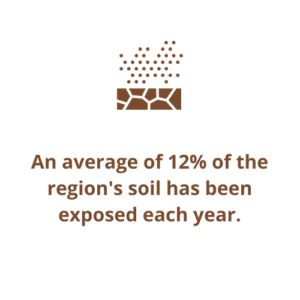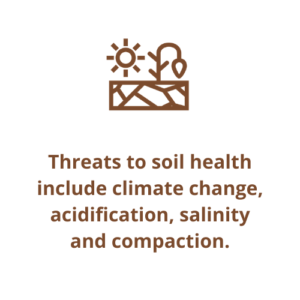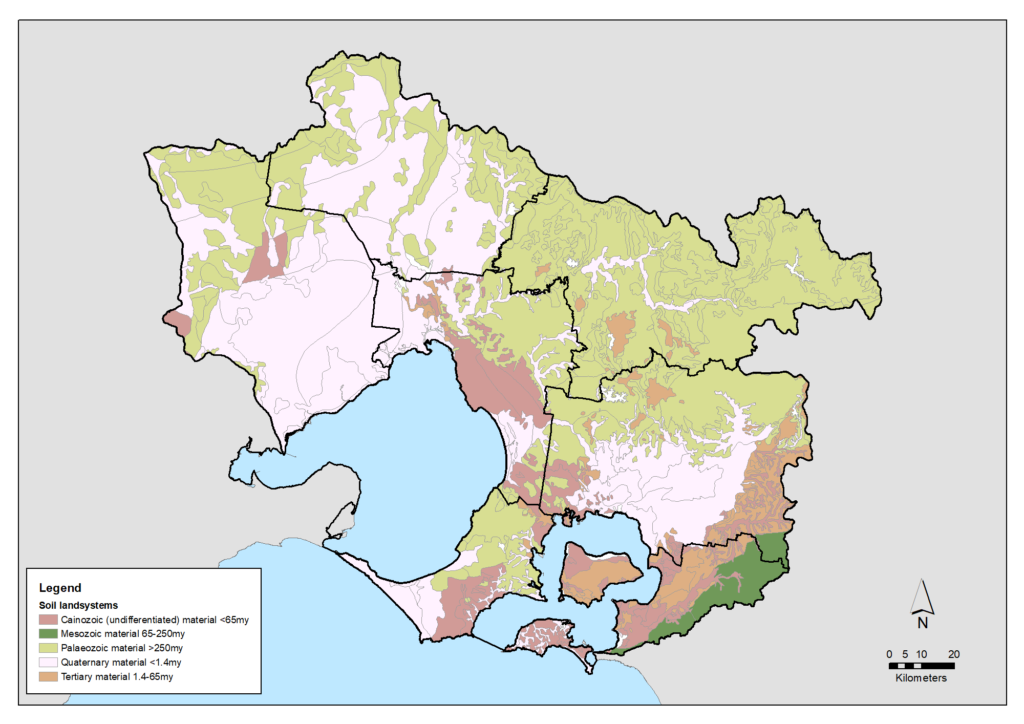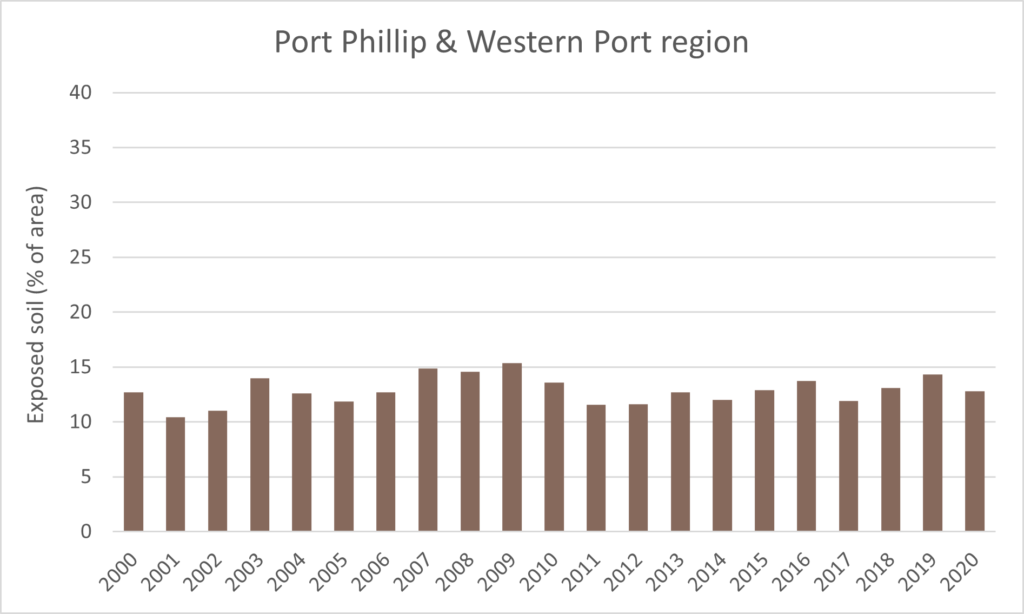A building block of life and prosperity
Healthy soils are central to human health and wellbeing. They support the production of food and fibre we need to survive and support the ecosystems which enable clean water, pure air, biodiversity and environmental quality.
Soil is a mix of mineral particles, organic matter, gases, water and living organisms. A teaspoon of soil is estimated to contain several thousand species of micro-organisms, and other invertebrates such as nematodes (round worms), annelids (earth worms), and microarthropods (springtails and mites). These soil organisms play very important roles such as breaking down organic matter and providing nutrients to plants.
Soils provide the physical substrate that supports our buildings and infrastructure in urban and rural areas. Healthy soils are also vital to our region’s economic prosperity, helping to generate more than $1.66 billion worth of agricultural production to the region’s economy each year.
Soils are a key component of the geodiversity of our region, the geological and physical elements of nature that, together with biodiversity, constitute the natural diversity of the region. The rocks and landforms of the region are other major components of the region’s geodiversity. Soils, rocks and landforms are also integral to the region’s geoheritage, by providing a natural record of land forming events.
Our region’s soils are ancient and fragile. The plants, animals and microorganisms that have maintained them for millennia are stressed through the introduction of European plants, animals and farming techniques. Today, there are many issues that affect our soils and landscapes including climate change, acidification, compaction, salinity, erosion, dumping of clean or contaminated soil, fertility decline, and decline of biodiversity.
Safeguarding the health of our soils is vital to our region’s future. The costs from degraded soils and their management can be very high and impact agricultural producers, commerce, industry and urban users, and the natural ecosystem.
Policy and planning
At the national level, the Australian Government has released a National Soil Strategy with goals to:
- Prioritise soil health
- Empower soil innovation and stewards
- Strengthen soil knowledge and capability.
At the state level, the Victorian Department of Energy, Environment and Climate Action (DEECA) has a key role in developing and implementing soil health policy. The Environment Protection Authority plays an important role in the protection of human health and the environment, including soils, from pollution and waste.
The Victorian Government has legislative requirements for reporting on change in soil condition under the Catchment and Land Protection Act (1994) by the Victorian Catchment Management Council and the Commissioner for Environmental Sustainability Act (2003) by the Commissioner for Environmental Sustainability. Both report every five years. This reporting is important to identify any important change in soil condition that might trigger government intervention.
Many features of key importance to the geodiversity and geoheritage of the region have been identified as Sites of Geological and Geomorphological Significance. The Victorian Environmental Assessment Council is required to have regard to these sites when carrying out investigations and making recommendations. It is good practice for everyone to have regard to sites of geological and geomorphological significance when planning and undertaking activities that may affect those sites.
The region’s soils now
The Port Phillip and Westernport region has a variety of soil types that reflect the geology, geomorphology and climate of the region, as indicated in the map below.
The geology, geomorphology and soils of the region define the physical framework for terrestrial, aquatic and coastal habitats. An understanding of geology, geomorphology and soils is relevant to environmental restoration and landscape design, for example, for informing the selection of plant species suitable for local soil conditions and the selection of landscaping materials compatible with the local geology.
Further information is available in soil type fact sheets and soil/landform mapping for some areas of this region.
The health of soils
Factors that should be considered in assessing soil health include soil acidity (pH), phosphorous and nitrogen levels, soil salinity, soil compaction and microbial health. Soil carbon is also important, and becoming increasingly so, due to the importance of sequestering and retaining carbon to help address climate change.
The health of soil, as measured by these parameters, is highly variable at local level due to the particular local conditions and the management history of the site.
The condition and trends of soil health using these parameters have not been systematically recorded and mapped at landscape level. Instead, a proxy for broad soil health and vulnerability assessment, for which data has been collected and mapped for some decades nationally through the Australian National University, is the percentage of exposed soil.
The graph below shows that, across the region over the past 20 years, the proportion of exposed soil has been steady at between 10% to 15%. This is a relatively low level.
Proportion of exposed soils for the region from 2000 to 2020 (with data from Australian National University)
Key challenges and opportunities
Climate change
Climate change has the potential to have a severe, but variable, impact on soils and landforms, depending on local climatic conditions and the existing vulnerability of the site. Droughts will require agricultural land to be irrigated and fertilized more to maintain productivity, while erosion and landslips caused through more intense rainfall and flash flooding can have significant implications for natural assets, agricultural lands, water quality and public safety. More frequent large bushfires will increase the extent of bare soil that is exposed to erosion. Sea level rise will increase salinity in coastal areas and is expected to cause increased coastal erosion.
To help achieve net zero carbon emissions, more or better ways for capturing and storing carbon in soil are also expected to emerge, and may offer opportunities for agricultural industries.
Soil erosion and landslips
Soil erosion processes in the region include gully, tunnel, rill and sheet erosion. Historically, extensive soil conservation works were undertaken in parts of the region, particularly the north and west, to address these types of erosion. These works included land management measures, contour banks, ripping and filling areas of tunnel erosion, and gully control structures. The present degree of apparent stability in areas where these historical soil conservation works were undertaken is strongly influenced by the ongoing persistence and integrity of the works. A latent soil erosion hazard remains present in these areas, with the risk of erosion reactivation should the soil conservation works deteriorate or fail.
Sodic and dispersive soils present a particularly high erosion hazard if they are disturbed, also resulting in pollution of downstream waterways with turbid plumes of fine sediment. The Parwan Creek valley contains some well-known examples. Sodic and dispersive soils have recently emerged as significant issue for new urban and infrastructure development in Melbourne’s outer north.
Wind erosion also occurs in the region, particularly on coastal dunes, but may also occur in other areas where bare soil is exposed. Data collected by the Australian National University shows that the proportion of exposed soil across the region over the past 20 year has been between 10% to 15%.
Some slopes in the region are susceptible to landslips. The incidence of landslip is influenced by a range of factors including geology, soils and slope angle. Areas with a higher susceptibility to landslip include some mountain slopes in the Dandenong Ranges as well as escarpments along deeply incised river and creek valleys, and coastal escarpments.
The Victoria Planning Provisions include an Erosion Management Overlay that is intended to minimise land disturbance in areas prone to erosion, landslip and land degradation. Several municipalities in the region have included Erosion Management Overlays in their planning schemes to identify areas prone to soil erosion or landslip, including the City of Moreland, Mitchell Shire, Mornington Peninsula Shire and the Yarra Ranges Council.
Moving towards sustainable agriculture techniques
There have been many changes in agricultural management in recent decades, and while these have often resulted in positive soil health outcomes there is still a need to broaden the adoption of practices that protect and improve soil. In particular, reduction in tillage, retention of organic residues and control of stock traffic play key roles in improving soil structure and hydrological properties as well as maintaining or increasing yields. These “regenerative agriculture” practices also improve the ability of soils to capture atmospheric carbon. They hold significant potential for farming to participate in carbon trading markets. Adoption of these practices more widely will be supported by better information but there are areas where long–established practices work against these principles.
Acidification
Soil acidification restricts options for land management because it limits the choice of crops and vegetation to acid-tolerant species and varieties. It is relatively straightforward to reverse short-term surface soil acidification through the application of lime. However, it is much harder to reverse the problem if the acidification has advanced deeper into the soil profile, because incorporating lime at depth is more expensive.
Coastal Acid Sulfate Soils
Coastal acid sulfate soils (CASS) potentially occur across coastal and estuarine lowlands in the region. These soils contain sulfuric acid or have the potential to form sulfuric acid when exposed to oxygen. Disturbance of CASS poses significant onsite and offsite risks and it is preferable that disturbance of CASS is avoided. The Victorian Coastal Acid Sulfate Soils Strategy sets out a coordinated approach for the management of CASS in Victoria.
Soil structure decline and compaction
Structure is an essential part of soil health and its ability to support plants and soil organisms. Air spaces between soil particles are essential to the movement and exchange of water, gases and plant roots.
Compaction occurs when the air spaces between soil particles are lost due to vehicle traffic, animal hoof impact and cultivation. Compaction restricts root penetration and micro-organism activity. Compaction is preferably avoided as it is difficult to remediate. The deeper impact of vehicle traffic is more difficult to remediate than surface compaction from animal hooves. Compaction leads to or exacerbates water logging and anaerobic soil conditions and impedes plant growth. Preferential flow paths formed by ruts and furrows can cause or exacerbate soil erosion. Soils in many parts of the Port Phillip & Western Port region have now been damaged by compaction by vehicles, stock and cultivation for over 180 years.
Salinity
Soil salinity occurs when salts accumulate in the soil profile to such an extent that plant growth is adversely affected.
The physical environment changes both in the immediate area (with degradation of wildlife habitat and the environment) and down-stream from the affected areas. Rivers and streams receive salt laden run-off and sediment as soil structure degrades and erosion occurs. The quality of water supplies for urban, livestock and domestic purposes deteriorates.
Rarely can one land manager solve a salinity problem. While sometimes causes and effects can be seen within a single property, mostly the cause and effects cross property boundaries. Everyone in a catchment is affected by the agricultural activities of others in it. Therefore, effective salinity management requires a total catchment approach.
Dumping of clean or contaminated soil
Disposing of unwanted clean fill or contaminated soil is a challenge across all of Victoria, however this issue is compounded in the green wedges and peri-urban areas due to their proximity to metropolitan Melbourne. Unregulated soil and earth storage can negatively impact waterways, ecosystems, landscapes, habitat, and agricultural land.
Vision and targets for the future
Vision
The National Soil Strategy includes the following vision:
Australia’s soil is recognised and valued as a key national asset by all stakeholders. It is better understood and sustainably managed, to benefit and secure our environment, economy, food, infrastructure, health, biodiversity, and communities – now and in the future.
Regional Catchment Strategy target
Contributing to the long-term achievement of this vision, our broad regional target for soil health is outlined below.
Progress towards this target will be monitored by accessing the assessments undertaken each year through the Australian National University.
Target 8.1 – Exposed soil
Partner organisations
The following organisations formally support the pursuit of the visions and targets for soil health. They have agreed to provide leadership and support to help achieve optimum results with their available resources, in ways such as:
- Fostering partnerships and sharing knowledge, experiences and information with other organisations and the community
- Seeking and securing resources for the area and undertaking work that will contribute to achieving the visions and targets
- Assisting with monitoring and reporting on the condition of the area.
Victorian Government
- Department of Energy, Environment and Climate Action (DEECA)
- Melbourne Water
- Environment Protection Authority Victoria (EPA)
- Sustainability Victoria
- Trust for Nature
- Westernport Water
Local Government
- Hume City Council
- City of Whittlesea
- Macedon Ranges Shire Council
- Wyndham City
- Moorabool Shire Council
- Western Alliance for Greenhouse Action
- Northern Alliance for Greenhouse Action
- South East Councils Climate Change Alliance
- City of Greater Geelong
- Brimbank City Council
- City of Greater Dandenong
- City of Casey
- Cardinia Shire Council
- Baw Baw Shire Council
- Bass Coast Shire Council
- South Gippsland Shire Council
- Eastern Alliance for Greenhouse Action
Traditional Owners
- Wadawurrung Traditional Owners Aboriginal Corporation
- Bunurong Land Council Aboriginal Corporation
Non Government
- GippsDairy
- The Nature Conservancy
- Habitat Restoration Fund
- OzFish Unlimited
- The People and Parks Foundation
Community
- NatureWest
- Friends of Lower Kororoit Creek Inc
- Werribee River Association
- Federation for Environment and Horticulture in the Macedon Ranges
- Upper Deep Creek Landcare Network
- Jacksons Creek EcoNetwork
- Friends of Emu Bottom Wetlands Reserve
- Friends of Daly Nature Reserve
- Deep Creek Landcare Group
- Riddells Creek Landcare Group
- Newham and District Landcare Group
- Merri Creek Management Committee
- Nillumbik Landcare Network
- Yarra Ranges Landcare Network
- Northern Yarra Landcare Network
- Nangana Landcare Network
- Johns Hill Landcare Group
- Kooyongkoot Alliance
- Gippsland Threatened Species Action Group
- Friends of Olinda Creek
- Abbotsford Riverbankers Inc
- Mornington Peninsula Landcare Network
- Main Creek Catchment Landcare Group
- Sheepwash Creek Catchment Landcare Group
- Manton and Stony Creeks Landcare Group
- Merricks Coolart Catchment Landcare Group
- Cardinia Environment Coalition
- Phillip Island Landcare Group
- Western Port Catchment Landcare Network
- Westernport Swamp Landcare Group
- Bass Coast Landcare Network
- Bass Valley Landcare Group
- French Island Landcare Group
- South Gippsland Landcare Network
- Loch-Nyora Landcare Group
- Mt. Lyall Landcare Group
- Poowong & District Landcare Group
- Triholm Landcare Group
Add your organisation as a supporter and partner
If your organisation supports these directions and targets for soil health and wishes to be listed as a partner organisation, you can request to be listed as a partner organisation. Adding your organisation to this list will:
- Enable your organisation to list one or more priority projects in the Prospectus which will describe how your priority project will pursue the targets of this Regional Catchment Strategy and potentially make your organisation’s project more attractive to investors by using the strategy to highlight its relevance and value
- Demonstrate your commitment to a healthy and sustainable environment
- Demonstrate the level of community engagement and support for this work.
Priority projects to move forward
Priority projects
There are significant ongoing programs and initiatives undertaken by many organisations in this region that are vital for protecting and enhancing soil health and are priorities to continue. In addition, there are numerous project proposals that, if funded and implemented, can contribute to achieving the Regional Catchment Strategy’s visions and targets. Project proposals include:
- Fert$mart led by GippsDairy
- Soil, Water and Biodiversity Stewardship on Farms proposed by Melbourne Water
- Healthy soils 500+ proposed by Melbourne Water
- Small Farms, Big Gains proposed by Melbourne Water
- Regenerative agriculture skills and capacity development proposed by the Mornington Peninsula Shire Council
- Practical Regenerative Agricultural Communities program led by Macedon Ranges Shire Council.
A full list of project proposals across the region and their key details can be viewed on the Prospectus section of this website.
Propose a new priority project
As part of the ongoing development and refinement of this Regional Catchment Strategy, additional priority projects may be considered for inclusion in the Prospectus.
If your organisation supports the directions and targets for soil health, and has a project it would like highlighted and supported in this Regional Catchment Strategy, please submit a Prospectus Project Proposal.

